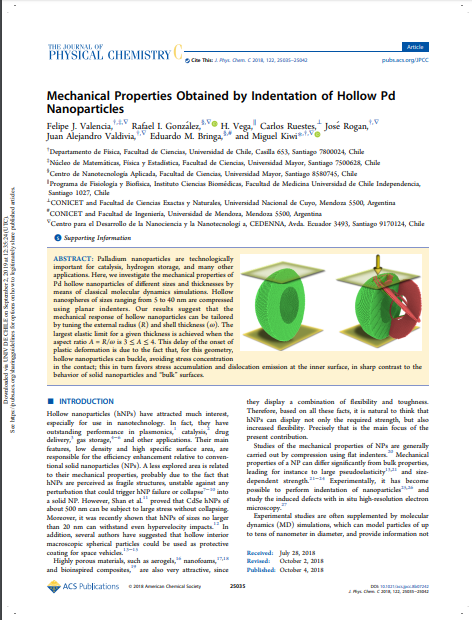Mechanical Properties Obtained by Indentation of Hollow Pd Nanoparticles

Fecha
2018Autor
González, Rafael I. [Univ Mayor, Fac Ciencias, Ctr Nanotecnol Aplicada, Santiago, Chile]
Bringa, Eduardo M. [Univ Mayor, Fac Ciencias, Ctr Nanotecnol Aplicada]
Valencia, Felipe J.
Rogan, José
Valdivia, Juan Alejandro
Sofo, Jorge
Kiwi, Miguel
Muñoz, Francisco
Ubicación geográfica
Notas
HERRAMIENTAS
Acceda a títulos restringidos
¿Cómo descargar?Resumen
Palladium nanoparticles are technologically important for catalysis, hydrogen storage, and many other applications. Here, we investigate the mechanical properties of Pd hollow nanoparticles of different sizes and thicknesses by means of classical molecular dynamics simulations. Hollow nanospheres of sizes ranging from 5 to 40 nm are compressed using planar indenters. Our results suggest that the mechanical response of hollow nanoparticles can be tailored by tuning the external radius (R) and shell thickness (omega). The largest elastic limit for a given thickness is achieved when the aspect ratio A = R/omega is 3 <= A <= 4. This delay of the onset of plastic deformation is due to the fact that, for this geometry, hollow nanoparticles can buckle, avoiding stress concentration in the contact; this in turn favors stress accumulation and dislocation behavior of solid nanoparticles and"bulk"surfaces.
Coleccion/es a la/s que pertenece:
Si usted es autor(a) de este documento y NO desea que su publicación tenga acceso público en este repositorio, por favor complete el formulario aquí.